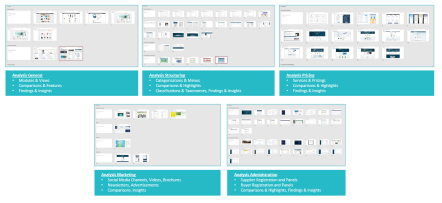
06 Jun PHArA‐ON: Competitor analysis for maximising commercial exploitation through CATAALOG Marketplace
B2B marketplaces are changing the business model in many industries, and recently the health and care sector has been strongly affected by this change. The CATAALOG marketplace is an innovative approach for maximising the exploitable results of the PHArA‐ON project. In order to maximise its impacts a competitor analysis was conducted. The overall goal was to get a global overview of the relevant B2B marketplaces and to position the CATAALOG solution successfully in the market.
Companies and governments are increasingly turning to B2B (Business to Business) and B2G (Business to Government) marketplaces to search for new suppliers, medical equipment, healthcare products and services. A competitor analysis of the CATAALOG marketplace has been carried out to get an overview of competing B2B marketplaces in the health and care sector. Such an overview is not only important to gain a better understanding of the relevant landscape but it is also essential to derive successful and applicable revenue models as well as marketing strategies for the CATAALOG solution. Furthermore, it helps to identify the strengths and weaknesses of existing solutions that can be successfully solved by the CATAALOG marketplace.
Methodology
To get an overview of the current marketplace landscape, a structured and methodological approach was developed. The first step of the analysis was to identify all relevant B2B and B2G marketplaces offering products and services of different suppliers and providers in the health and care sector. More specifically, the objective was to find marketplaces similar to the CATAALOG marketplace i.e., horizontal (with wide range of customers across the health and care sector) and open marketplaces offering products and services in the field of Ambient and Assisted Living (AAL). The desk research was conducted through extensive search queries using various search engines and different combinations of keywords in English and German.
The data collection included general data like links to the marketplaces, price data, and marketing data. The resulting information was used to further categorize and compare the different marketplaces. An in‐depth analysis of each marketplace was then conducted using the following segments:
The GENERAL section contains an overview of different modules and views, including a comparison of features and general findings.
The STRUCTURING section covers the analysis of product and service categories, menus and different classifications, as well as, health and care products and services.
The PRICING section covers a wide range of pricing models and services.
The MARKETING section includes a qualitative and quantitative analysis of commonly used marketing methods such as social media channels, videos, brochures and newsletters.
The ADMINISTRATION section contains a comparison of different registration panels for buyers and suppliers.

SWOT analysis
A SWOT analysis was conducted to assess the marketplaces through an in‐depth analysis based on strengths, weaknesses, opportunities, and threats. Additionally, the most promising marketplaces were rated using a Likert Scale, i.e., a rating from 1 (poor) to 5 (excellent) stars. The results of the analysis have shown that large marketplaces exist and cover a wide range of products and services. However, most of them lack usability, a critical mass of users, accessibility and product range. These findings will help to successfully position products and services deployed in the PHArA‐ON project using its CATAALOG solution ‐ a new generation of digital marketplaces.
Results
Finally, an in‐depth analysis of the top 5 competitive marketplaces with a variety of comparisons of different pricing models, marketing approaches and administration panels has been made. The final results were used to derive further structures and categorisations of products and services for the CATAALOG marketplace. In total 57 healthcare marketplaces were found, of which 21 are considered high‐quality. Of those 21 marketplaces, 7 niche marketplaces are owned by major healthcare companies. Based on the competitor’s analysis and the corresponding data collection, 97 product categories and 78 use cases were identified.
Links
https://twitter.com/PharaonProject
https://www.youtube.com/channel/UCQEJv9C3T‐‐xLXCldYaBWeQ
https://www.linkedin.com/company/pharaonproject/
https://www.linkedin.com/groups/12335464/
Keywords
Active and assisted living (AAL), B2B marketplace, B2G marketplace, platforms, marketplace, standards
